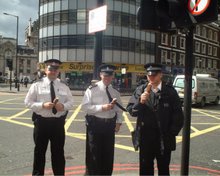

has been moved to new address
Sorry for inconvenience...



[This is a personal piece reflecting the views of one fitwatcher]
Sergeant Smellie’s acquittal yesterday at City of Westminster Magistrates’ Court, whilst disappointing, is hardly surprising. Many Fitwatchers know Smellie from his days as AB42 when he was often deployed in a FIT capacity and was frequently nasty, smug and aggressive, and whilst his attack upon Nicky Fisher wasn’t pleasant or justifiable, it was far from the worst of the G20 assaults.
However, the reality is the court was never going to believe Nicky Fisher over Smellie when she didn’t bother turning up for court. Under these circumstances it is surprising the trial even went ahead – if I was facing charges of assaulting a police officer and the cop didn’t show up, I would expect the case to be dropped, and I suspect only political expediency ensured the case’s progression.
Smellie’s defence, whilst smattered with bullshit, was credible enough to pass the beyond reasonable doubt test of British justice especially when two prosecution witnesses testified unfavourably reagarding Fisher’s behaviour. There may be conspiracy theories as to why the prosecution called witnesses who undermined their case, but I suspect it may be nothing more than an inept, lazy Crown Prosecution Service to blame.
Unfortunately, this case has acted as a smokescreen meaning the important questions were not asked and the right people not challenged. Smellie was following orders to clear the road and was doing so in the manner he was trained. Only following orders is not a defence under any circumstances, but attempting to prosecute Smellie without seeking to blame the officers who gave the orders is meaningless. Equally, prosecuting him for following his training in acting like a violent thug is meaningless without questioning his training and deployment.
Meanwhile there has been no justice for Ian Tomlinson. The identity of the police officer who attacked him is still unknown, and the FIT officers involved, Discombe and Palfry are still policing our protests. Of the 212 complaints forwarded to the IPCC none have had any kind of meaningful resolution.
Perhaps the only good which can come out of this debacle is lack of faith in the system. Real change will only occur when we stop relying on public/political bodies to fight our battles for us. It is down to ordinary people everywhere to hold the police to account, and this will only happen when we stop playing the victim and start fighting back.







